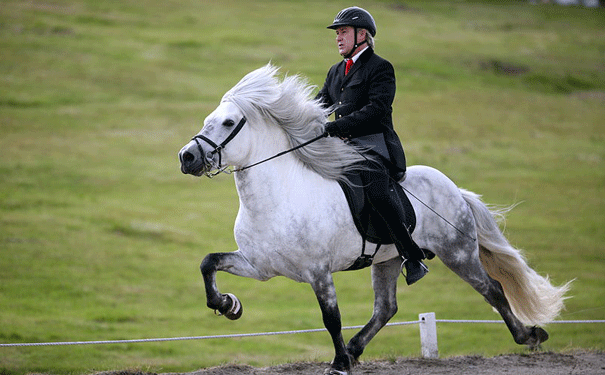
The Icelandic horse is a "five-gaited" breed: it can walk, trot, canter/gallop, tölt and pace. Image: Wikimedia Commons
Scientists have found that one gene is responsible for variability in locomotion in horses and mice.
Traits such as height are controlled by the interaction of up to 700 genes. So it came as quite a shock to researchers from Uppsala University (UU) and their international collaborators that the mutation of just a single gene is responsible for variability in locomotion in horses and mice. Furthermore, the research team discovered that this gene, DMRT3, is expressed in a previously unknown set of neurons in the spinal cord. These findings provide insight into the neural circuits that coordinate movement in vertebrates.
“The amazing result was that we found one very strong signal on one chromosome which by further work led to the discovery of the DMRT3 mutation,” explains Leif Andersson, co-author of the paper published in Nature, from UU and Swedish University of Agricultural Sciences. “This was unexpected since we had [anticipated] a much more complex genetic background for a trait like this.”
Horses were the perfect choice for the researchers to test the genetic basis of variability in locomotion. This is because there are several naturally occurring gaits that these animals can perform, including walking, trotting, cantering and galloping. Icelandic horses can tölt, which is a sort of ambling gait and they can also perform flying pace. The scientists wanted to know why some horses have more variability in their gait than others and whether it could be genetically explained.
First they demonstrated that a single base change in DMRT3, which resulted in the production of a truncated form of the gene, was the mutation associated with pacing in horses. They developed a diagnostic screening test and found that this mutation is common among horses bred for harness racing, such as the Tenessee Walking Horse and the Paso Fino breeds.
“Our interpretation is that the mutation inhibits the transition from trot to gallop and thereby allows the horse to trot at a very high speed,” explained Andersson in a press release.
The Swedish scientists further explored the function of DMRT3 in a mouse neurobiological model. They showed that the neural circuits of knockout mice lacking the gene did not develop properly and had an altered pattern of locomotion. But fascinatingly these mice could eventually move somewhat normally, suggesting that other neural circuits compensate for the loss of DMRT3. This shows how the nervous system is flexible and capable of adapting to the absence of key genes.
“This paper by Andersson and colleagues beautifully illustrates the new power to translate findings of molecular genetics into an improved understanding of the basics of how the nervous system develops its anatomy and physiology,” says Bill Phillips from the University of Sydney who was not involved with the study.
The researchers plan to do two main follow up experiments in horses. The first will look at the worldwide distribution of the mutation of DMRT3 from an evolutionary perspective to shed light on where it first appeared and how it could have spread. It is interesting to think that for over a thousand years, humans have been breeding the horses which have patterns of locomotion that make them useful for certain purposes, such as the Icelandic Horse’s ambling gait, which makes for a smoother ride. But only now are we beginning to understand what causes this variability on from genetic level. The team also hope to identify any additional genes that might modify the phenotype associated with DMRT3.
This research is not just valuable in the breeding of domestic animals: “We find it likely that these neurons are also present in humans and could thus provide an entry point for modification or initiation of walking behaviours,” says co-author Klas Kullander from the Department of Neuroscience at UU. “This is valuable in efforts to try to restore walking in humans that have a damaged spinal cord.”
Source: Uppsala University






